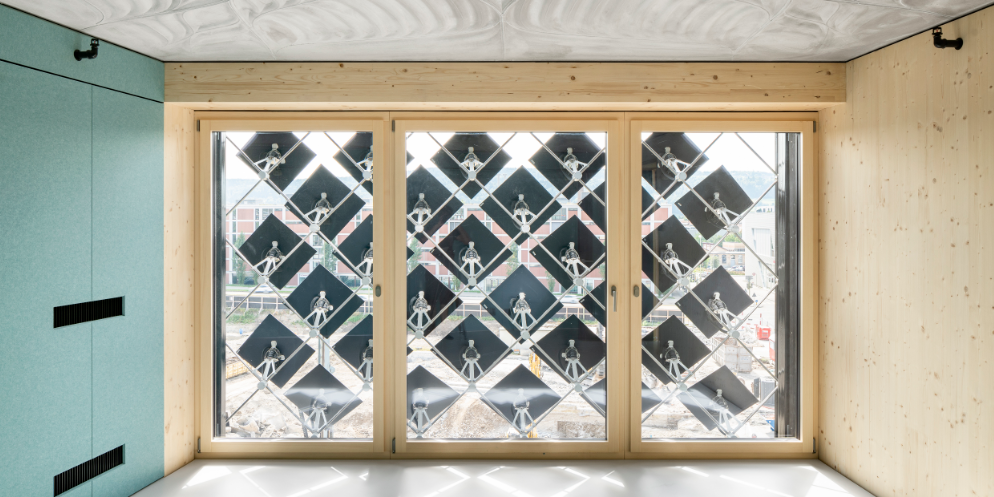“NEST provides the ideal environment to further develop our innovation”

Building façades hold great potential for producing and saving energy. Today, however, this potential is still too little used. As part of the NEST HiLo unit, researchers from the Architecture and Building Systems Group at ETH Zurich have developed an innovative adaptive solar façade that simultaneously optimises electricity production and energy savings. Demonstrators of the façade were tested at the HiLo unit. With the founding of the ETH Zurich spin-off "Zurich Soft Robotics", the product is now to be launched on the market under the name "Solskin".
Buildings are responsible for more than 40 per cent of global energy consumption. A large part of this is used to ensure user comfort – i.e. for heating and cooling. Especially in view of the current developments in the energy market, the big question is how we can cover our energy consumption in the future. Ways must be found to tap new energy sources and at the same time reduce the energy consumption of buildings. One of these could be the better use of façade surfaces.
This certainly holds potential, since the majority of the building façade is still unused and at the same time the central factor for either letting energy into the building or keeping it inside. Researchers at ETH Zurich have therefore developed an innovation as part of the NEST HiLo unit that can exploit this potential: an adaptive solar façade that not only optimises electricity production, but also reduces energy loss at the same time. Attached to the actual façade, this forms a kind of second skin for the building. The innovation thus also bears the appropriate name “Solskin”.
Simple architectural embedding
“We wanted to develop a façade that could be very easily installed on a building and optimally integrated into the architecture,” Bratislav Svetozarevic explains the idea behind the innovation. He was significantly involved in the development of “Solskin” from the beginning, first in 2014 as a PhD student in Arno Schlüter’s “Architecture and Building Systems” group at ETH Zurich and from 2018 as a Post Doc at ETH and Empa, where he researched related topics.
“Solskin” consists of a lightweight substructure that is attached to the façade. Mounted on it are small square thin-film solar panels that can be colour-matched to the existing building envelope. In this way, the solar façade blends in perfectly with the overall appearance of the building. At the same time, the panels can be turned individually in all directions. This is because behind each module there is a control unit that Svetozarevic and his colleagues have developed over the years. The special thing about it is that the panels are aligned using air pressure. The materials used are both robust and flexible so that the system can withstand strong gusts of wind and precipitation.
Reality check
The idea behind the flexible alignment is that the solar façade can follow the position of the sun, thereby optimising electricity production. At the same time, “Solskin” also serves to actively shade the building in summer, thus reducing the need for cooling, or to open the panels and let the sun’s rays into the interior, thus saving heating energy in winter.
The first prototype tests at ETH Zurich have convinced the researchers of the innovation’s applicability. But would the innovative façade also work on a real building? To find the answer to this question, “Solskin” was attached to the façade of the HiLo unit. “HiLo offered us the opportunity to install and test our system on a busy building for the first time. This enabled us to record the usage and acceptance of the users,” explains Svetozarevic. An important factor, because in addition to the actual system, the researchers also developed an algorithm that records the needs of the people working in the HiLo unit and can thus improve user comfort in addition to optimising production. This is now being further developed with the help of data from operation at NEST.
A bright future
The results of the prototypes and the pilot project at NEST point in a clear direction: energy can be saved with “Solskin” – and saved enormously. While solar production can be increased by up to 40 per cent compared to conventional solutions, savings of up to 80 per cent are possible in heating and cooling energy compared to a conventional, non-adaptable shading system. “We are pleased that we were able to show at NEST that our system works and what potential it has,” says Svetozarevic, beaming. Various expert juries were also convinced of this potential and awarded “Solksin”. Among the awards is the renowned Watt d’Or, which is awarded annually by the Federal Office of Energy.
The next step is now commercialisation. To this end, Bratislav Svetozarevic and his team founded the spin-off “Zurich Soft Robotics” in 2022 and have already landed a major contract. The company KELLER Druckmesstechnik AG in Winterthur wants to attach “Solskin” to its new production building – on a total area of 1,300m2.
In addition to its use on new buildings, however, the innovation is also ideal for upgrading older buildings. Solskin” thus has great potential to optimise the energy efficiency of the entire building stock and thus provide an answer to the question of how we can continue to generate enough energy to operate our buildings in the future.